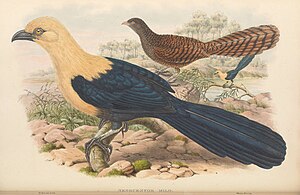Pale head cuckoo
| Pale head cuckoo | ||||||||
|---|---|---|---|---|---|---|---|---|

Pale head cuckoo ( Centropus milo ) |
||||||||
| Systematics | ||||||||
|
||||||||
| Scientific name | ||||||||
| Centropus milo | ||||||||
| Gould , 1856 |
The pale head cuckoo ( Centropus milo ) is a species of cuckoo from the genus of the spur cuckoo ( Centropus ). It is endemic to some islands in the Solomon Islands .
features
Pale head cuckoos are 60 to 68 cm in size and are large spur cuckoos with heavy bills and short wings. They are roughly the size of a female pheasant . The wing length is 245 to 290 mm, the tail length 312 to 410 mm, the beak length 52 to 73 mm and the length of the rear toe claws 17 to 23 mm. The plumage of the adult animals is yellow-brown on the head, upper back and underside. The wings, lower back, and tail are of a glossy black. The iris in adults is red to reddish brown, legs and beak are dark gray to black, and the feet are blue-black.
Juvenile animals are colored differently, the wings and the long tail are reddish brown with black horizontal stripes like the related pheasant-spurred cuckoo ( Centropus phasianinus ). The rest of the feathers are brown with black flecks. The iris is brown-gray. Juvenile birds are two-colored, the top is brown and the bottom is whitish. The feet are blue-gray.
In the subspecies C. m. albividentris ( Rotschild , 1904) the yellow-brown of the upper side is lighter than that of the nominate form. It is more of a lighter yellow-brown that plays into the whitish.
Occurrence
The distribution of the pale head cuckoo is limited to the Solomon Islands, and even there not to all islands. They occur on Guadalcanal and the Nggela Islands (formerly known as "Florida Islands").
The subspecies C. m. albividentris is found in the southwestern New Georgia Archipelago , there on the islands of Ghizo , Kohinggo , Kolombangara , Mbava , New Georgia , Nggatokae , Ranongga , Rendova , Simbo , Tetepare , Vangunu and Vella Lavella .
Pale head cuckoos prefer the lowlands up to 500 meters in height and usually stay on the ground. By BirdLife International of the bird as is ( "not at risk" least concern classified).
behavior
The birds make sawing and snoring noises, like a rattle, can also sound like a lion. Pairs alternate with an "urrh" and a "-uh". Individual birds emit a throaty bark as well as a deep ornamentation and a gentle grunt. In juveniles, it sounds like a stuttered cough.
They feed on insects, mainly ghosts , short-antennae terrors , beetles , pupae and large centipedes .
Steel monarchs ( Myiagra ferrocyanea ) react aggressively to pale head cuckoos. It is believed that this is because the cuckoos steal eggs and chicks from the steel monarchs.
Reproduction
Male pale head cuckoos usually have a single testicle and some have a rudimentary second testicle . The testicle is enlarged in February, May and October. The spur cuckoo is not a breeding parasite .
Pale head cuckoos and humans
Surname
Centropus is made up of the Greek κέντρον ( kentron ; center point, spur) and πούς ( pus ; foot) and means " spur foot". The type epithet milo refers to the Greek wrestler Milon (* around 555 BC; † after 510 BC) and alludes to the size of the bird.
In the subspecies C. m. albividentris is the specific epithet made up of the Latin albidus (whitish) and ventris (belonging to the belly) and means "white-bellied".
Postage stamps
A pale head cuckoo is on a Sl $ 7.50 stamp from a block of the Solomon Islands in honor of BirdlLife International from 2005.
Web links
- Centropus milo inthe IUCN Red List of Threatened Species 2015.4. Posted by: BirdLife International , 2012. Retrieved February 15, 2016.
- Videos, photos and audio recordings to Centropus milo in the Internet Bird Collection (English)
- xeno-canto: sound recordings - pale head cuckoo ( Centropus milo )
Individual evidence
- ↑ a b The pale head cuckoo in the Handbook of the Birds of the World (English)
- ↑ The Pale Head Cuckoo on Nature Watch NZ (English)
- ^ A b Robert B. Payne: The Cuckoos . (Bird Families of the World No. 15). Oxford University Press, 2005, ISBN 0-19-850213-3 : pp. 208f.
- ↑ Postage stamps with the motif Pale Head Cuckoo on bird-stamps.org (English)
